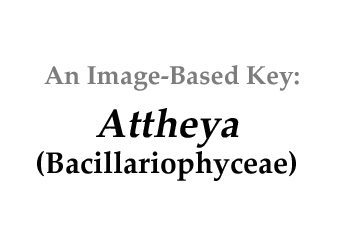|
Home / Bacillariophyceae / Centric / Unicells / Attheya |
||||
|
|
||||
|
|
||||
|
Click on images for larger format |
||||
Name derivation: |
||||
|
|
||||
Classification: |
||||
Attheya T.West, 1860. There are 14 species of which 8 have been accepted taxonomically.Order Chaetocerotales; Family Attheyaceae |
||||
Morphology: |
||||
|
In girdle view the cells are rectangular with two spine-like horns extending from the corners at each end of the cell. In some species there is a third horn that extends between the first two. They have many visible intercalary bands. There are few chromatophores that are disc shaped and are generally located at the midway between the two ends of the cell. |
||||
Similar genera: |
||||
|
Rhizoselenia is similar to Attheya except that it has only one spine at each end and is more elongated than the rectangular cells of Attheya. Chaetoceros is distinguished from Attheya by structure of valve horns. There is a more frequent appearance of resting spores in Chaetoceros. As mentioned by Edlund and Stoermer (1993), Attheya zachariasii J. Brun. was transferred to the monotypic genus Acanthoceras Honigmann (Simonsen, 1979). |
||||
Habitat: |
||||
|
Found in both marine and freshwater systems. It is widespread in Europe and in the United States, especially in the spring. It is also found in river systems. |
||||
References: |
||||
|
Whitford, L. A. and Schumacher G. J. A Manual Of Fresh-Water Algae. Sparks Press. (1973). Hasle, G. et al. Identifying Marine Phytoplankton. Academic Press. (1997). Guiry, M.D. and G.M. Guiry 2013. AlgaeBase. World-wide electronic publication, National University of Ireland, Galway. http://www.algaebase.org; searched on 19 September 2013. West, T. 1860. Remarks on some Diatomaceae new or imperfectly described and a new desmid. Transactions of the Royal Microscopical Society, series 2 8: 147-153. |
||||

